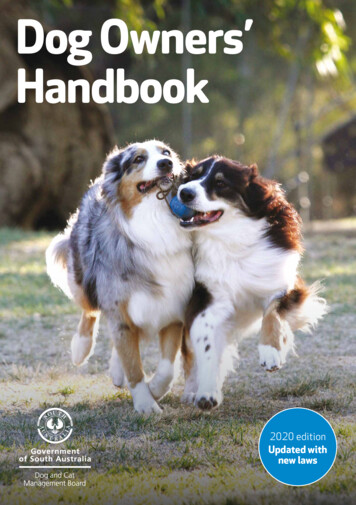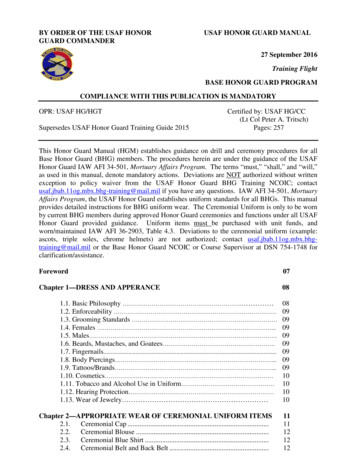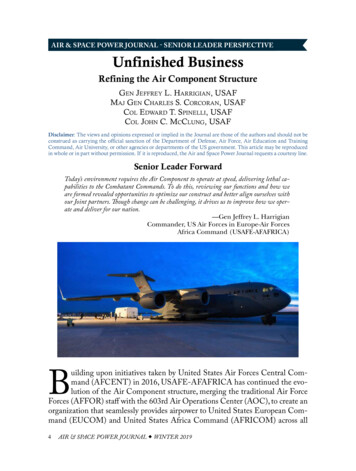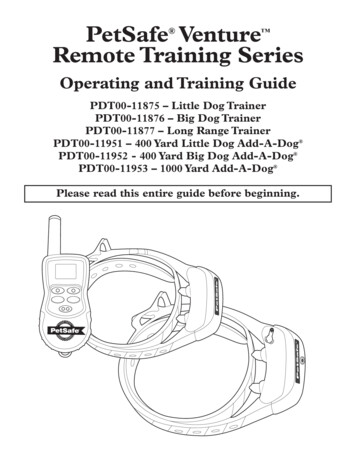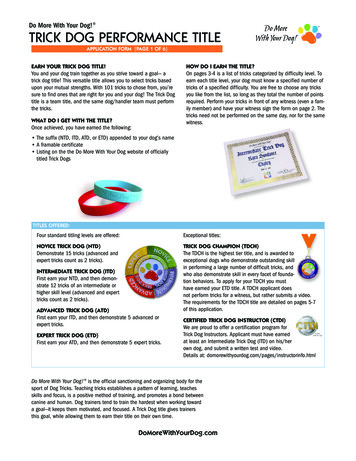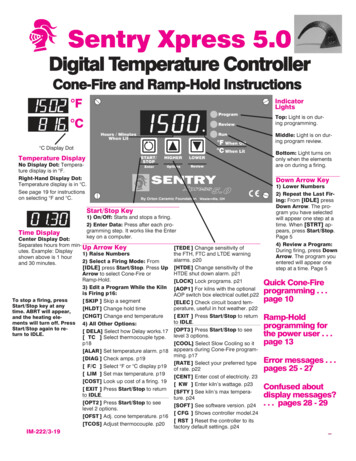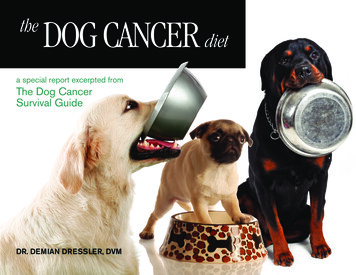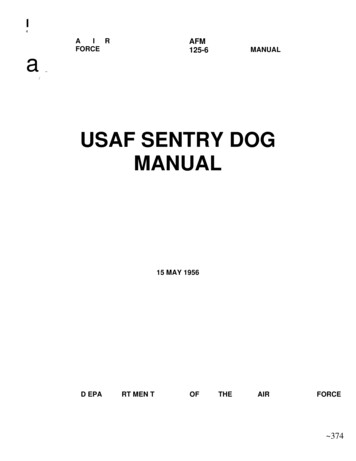
Transcription
I4AI RFORCEaAFM125-6MANUAL/USAF SENTRY DOGMANUAL15 MAY 1956D EPART MEN TOFTHEAIRFORCE 374
AFM 125-6AIR FORCE MANUALNUMBER 125-6DEPARTMENT OF THE AIRWASHINGTON, 1.5 MForeword1. Purpose and Scope. This manual prescribes the policies and procedures governing the operation and maintenance of the USAF Sentry DogProgram as established in AFR 125-9.2. Contents. This manual covers the following elements of the USAFSentry Dog Program: Qualifications, selection and training of handler personnel; procurement, training and utilization of sentry dogs; and the procedures for providing the necessary administrative, maintenance and logistical support.3. Recommendations. Suggestions for the improvement of the SentryDog Program and the measures prescribed in this manual are encouraged.They may be submitted through proper channels to The Inspector General,Headquarters, USAF, Washington 25, D. C., Attention: The Provost Marshal.BY ORDER OF THE SECRETARY OF THE AIR FORCE:OFFICIALN. F. TWININGChief of Staff, United States Air ForceE. E. TOROColonel, USAFAir Adjutant GeneralDISTRIBUTIONZone of Interior and Overseas:Headquarters USAFMajor air commandsSubordinate air commandsBasesSquadrons (Air Police)*Special* Commanders will requisition additional copies as required for issuing onecopy toeach dog handler. 3741508632
IS May 1956AFM 125—6ContentsPageChapter I —BackgroundSection I—Origins of TJSAF Sentry Dog ProgramSection Il—Objective of the Program13Chapter 2—Handler PersonnelSection I—Sentry Dog HandlersSection lI—Formal TrainingSection Ill—On-the-Job TrainingSection IV—Status of Trained Handlers4466Chapter 3—Sentry DogsSection I—The German Shepherd DogSection Il—Specifications for Sentry DogsSection Ill—Procurement778Chapter 4—TrainingSection I—Behavior and Instincts of DogsS ction Il—General Principles of Dog TrainingSection Ill—Basic Obedience TrainingSection IV—Advanced Obedience, Agitation and Attack TrainingSection V—Obstacle CourseSection VI—Utilization and Care of EquipmentSection VII—Continuous Training ProgramSection VIII—Elective TrainingSection IX—Standards of Proficiency91316202525272829Chapter 5—Health, Care and FeedingSection I—Grooming and CareSection Il—First Aid and Veterinary SupportSection Ill—Nutrition and Feeding313334Chapter 6—Utilization of Sentry DogsSection I—Sentry Dog FlightSection Il—Principles of UtilizationSection Ill—Areas of Utilization404142Chapter 7—Logistical Support and AdministrationSection I—Kennels and RunsSection Il—Equipment and SuppliesSection Ill—RecordsWi434445iii
Chapter IBACKGROUNDSection I—ORIGINS OF THE USAF SENTRY DOG PROGRAMI.Military Use of DogsThroughout the history of warfare, from thedays of the Medes and the Persians and theconquests of the Roman Empire, to the policeaction of the United Nations in Korea, dogs havegone into combat at the side of their masters orhave been used in direct support of combatoperations. Initially, entire formations of. attackdogs, frequently equipped with armor and spikedcollars, were sent into battle against the enemy asrecognized and effective instruments of offensivewarfare. However, with the invention ofgunpowder and the consequent change in militarytactics, the value of dogs as combat soldierssteadily diminished. At the same time, hisusefulness in other military activities hasincreased. During World War I, vast numbers ofdogs were employed as sentries, messengers,ammunition carriers, scouts, sled dogs andcasualty dogs. It is estimated that Germany aloneemployed over 30,000 dogs for such purposes,and approximately 20,000 dogs served with theFrench Army. The American ExpeditionaryForces had no organized dog unit, but borrowed alimited number of dogs from the French and Belgians for casualty, messenger and guard duty.During World War II, dogs were used on thelargest scale yet realized. In all, over 250,000dogs served with the armies of the Allies and theAxis Powers. Need for dogs in large numberswas recognized by theUnited States Army in 1942 and resulted in theestablishment of the K—9 Corps. Thisorganization operated five War Dog Receptionand Training Centers scattered throughout theUnited States and during the course of the wartrained approximately 10,000 dogs for thefollowing duties: messenger, 151; scout, 595;mine detection, 140; sled and pack, 368; andsentry, 9,298. A number of these dogsestablished distinguished records and wereofficially cited for outstanding and faithfulservice.2.Sentry Dogs in the Air ForceUtilization of dogs by the Air Force beganinitially in the two overseas commands, UnitedStates Air Forces in Europe and the Far East AirForces. During the past five years, both thesecommands have established programs for theprocurement and training of German Shepherdsfor use as sentry dogs. More recently, theStrategic Air Command began procuring andutilizing sentry dogs at its installations in thezone of the interior. As a consequence, by theend of 1955, a total of 1379 sentry dogs wereperforming duty at Air Force installations inKorea, Japan, Okinawa, Guam, Puerto Rico,Germany, France, Great Britain, French Moroccoand the Continental United States. This presentwidespread utilization of sentry dogs, plus anticipated increased requirements in the future, hasled the Air Force to establish the USAF SentryDog Program.V
15 May 1956AFM 125-6;r-#-’ 7rC’; rJ .v t# w -.v -rt.tjz.’ - — -- - ‘.— -,AFM125-6Aa)aSentry Dogs Lined up forInspection at an Air ForceBase.IS May 1956CV
.1Secton Il—OBJECTIVE OF THE PROGRAMThe USAF Sentry Dog Program has but one objective: To provide commanders with ameans for increasing the security of restricted areas and for protecting governmentproperty against theft or pilferage.2
AFM I25- IS May 1956Chapter 2HANDLER PERSONNELSection I—SENTRY DOG HANDLERSI.SourceThe handling and care of sentry dogs are partof the duties and responsibilities of a fullyqualified Air Policeman, AFSC t4 50, as setforth in AFM 35—1. Personnel selected fortraining and duty as sentry dog handlers will bedrawn from the existing t oo Career Fieldmanpower resources of the using installation. Noadditional manpower requirements will berecognized by participation in this program.concerned.b. Supervisors. At each installation receivingfive or more sentry dogs, one Air Policesupervisor, AFSC 77170, will be selected fortraining in kennel administration and sentry dogutilization. In addition to meeting the samequalifications as handler personnel, supervisorsmust possess a thorough knowledge of andexperience in security operations.3.2.Qualificationsa. Handlers:(1) Personnel selected for training andduty as sentry dog handlers must have a genuineliking for animals insofar as it is possible todetermine.(2) Only volunteers will be considered forthis duty.(3) Selectees must have at least 24months service retainability.(4) Air Policemen with AFSCs of T150, 113O and &Thi0 are eligible for handlertraining; however, helper-level personnel will bedirected duty assignment three-level personnelonly.(5) Security clearance requirements willbe as prescribed by the major air commandSelectionThe greatest care will be exercised in selecting NCOs and airmen for duty with sentrydogs. Commanders of Air Police units shouldinterview each potential handler to establish hisinterest in and suitability for duty with sentrydogs. It is necessary that handlers possess anatural, friendly and affectionate attitude towardanimals. Potential handlers must be advised thatthey will be held completely and solelyresponsible for the care and training of theirassigned sentry dogs and that duty with sentrydogs will normally be performed only at night.Any individual who evidences doubt orhesitation about participating in the programshould be eliminated from further consideration.Experience has proven that the best Air Policemen make the best dog handlers.Section Il—FORMAL TRAINING4. The Army Dog Training CenterExcept as provided in Section III below, AirForce personnel selected for duty withsentry dogs will complete the sentry doghandlers’ course conducted by the United StatesArmy Dog Training Cei t r Fort Carson,Colorado. This course is eig weeks in3
15 May 1956AFM 125-6Handler and Sentry Dog onDuty.4
15 May 1956duration and consists of instruction on thehandling, care, maintenance, training andutilization of sentry dogs. Shortly after reportingto the Center, each handler is assigned a sentrydog with which he trains throughout theremainder of the course. At the completion ofthe training period, handlers and their assigneddogs are returned to their home station. AirPolice supervisors, AFSC 77170, who willperform duty as NCOICs of the sentry dogflights at theirhome stations, will be assigned sentry dogs forAFM 125-6training purposes only and will not retain thedogs upon return to their home stations.5. Unsatisfactory PerformancePotential handlers who fail to demonstrate asatisfactory attitude or adaptability to sentry dogwork will be eliminated frdm the course ofinstruction and returned to their parentorganizations.5
15 May 1956AFM 125-6Handler and Sentry Dog UndergoingTraining.Section Ill—ON-THE-JOB-TRAINING6. AuthorityWhen authorized by the major air command,installations may train a limited number ofsentry dog handlers through an on-the-jobtraining program. Normally such training willnot be attempted until a highly proficient, wellorganized and thoroughly experienced sentrydog operation has been achieved. Under nocircumstances will the number of handlerstrained through OJT exceed the number ofhandlers trainedthrough formal instruction at the Army DogTraining Center. All supervisors will completeformal training at the Center and will not betrained through OJT.7. Training ProgramOJT training will be conducted in accordancewith the packaged OJT Program for sentry doghandlers listed in the USAF Training Prospectus.Section tV—STATUS OF TRAINED HANDLERSPersonnel who successfully complete eitherformal or on-the-job training as sentry doghandlers will be frozen in this specific functionfor a minimum period of 30 months and will bereported on personnel accounting rosters asCategory B, in accordance withSection XXIII, Part 3, AFM 171—5. Reassignment of handlers to other than sentry dogduties within less than 30 months after thecompletion of training must be approved by themajor air command.5
15 May 1956AFM 125-6AFM125-615 May1956Chapter 3SENTRY DOGSSection I—THE GERMAN SHEPHERD DOG1. The German Shepherd Dog has beenselected as the breed best suited to the needs ofthe Air Force. This determination was basedupon the German Shepherd’s demonstratedpossession of the following traits:keen sense of smell, endurance, reliability,speed, power, tractability, courage and ability toThe German Shepherd Dog.adapt to almost any climatic conditions.2. As a recognized breed, German Shepherds are relative newcomers to the canine world.The first organized effort to develop and promotethe breed dates from the founding of Der Vereinfur Deutsche Schaferhunde (Society for thePromotion of the Breeding of German ShepherdDogs) in 1899. Under the leadership of CaptainMax von Stephanitz, who headed thisorganization from 1899 until 1935, threeprincipal varieties of shepherd dogs indigenousto Germany were cross bred to produce theGerman Shepherd breed we know today.3. The modern German Shepherd is a workingdog, strong, agile, well-muscled, alert and full oflife. He is longer than he is tall, and has a deepbody with an outline of smooth curves, ratherthan angular. The ideal male is 25 inches highand weighs between 75 and 85 pounds; the bitchis two inches shorter and approximately 15pounds lighter. He has a distinct, direct, fearless,but not hostile, expression; a self-confidentpersonality, and a certain aloofness that does notlend itself to indiscriminate friendship. He is atrotting dog. His long effortless trot coversmaximum ground with a minimum number ofsteps, consistent with the size of the dog. Goodconformation calls for firmness of back andmuscles, and proper angularity of fore and hindquarters.Section II SPECIFICATIONS FOR USAF SENTRY DOGS4. German Shepherd Dogs procured for theAir Force will satisfy the followingspecifications:a. Breed. German Shepherd.b. Sex. Dogs and bitches. Bitches must6have been spayed at least 120 days prior toacceptance.c. Age. Twelve to 36 months old.d. Temperament. Alert, intelligent, confidentand obedient to the wishes of its owner.
—, ‘— .—. — -—‘——-—- - - -7
—, ‘— .—. — -—‘——-—- - - -e. Conformation to Breed. Conform closelyto the description and standards approved by theAmerican Kennel Club for the German ShepherdDog. Minimum height: 21 inches; minimumweight: 50 pounds.f. Health. A certificate of health from aqualified veterinarian must accompany each dog.This certificate must include informationon innoculations for rabies and distemper, resultof test for heartworm, and the spayed conditionof bitches.g. Acceptance. The government reserves theright to return at government expense within 30days after date of delivery any dogs which forany reason are not acceptable.Section Ill—PROCUREMENT5. Under the terms of an inter-serviceagreement between the Department of the AirForce and the Department of the Army, theQuartermaster General, United StatesArmy will procure all sentry dogs required6. All offers concerning the sale or donationof dogs for the USAF Sentry Dog Program willbe forwarded direct to the Remount Section, theQuartermaster General, U. S. Army, Washin on25, D. C.by the Air Force.7
AFM 125-6IS May 1956Chapter 4TRAININGSection I—BEHAVIOR AND INSTINCTSI. GeneralThe dog’s world differs from the human insome very specific ways. His world ispredominantly one of odors. His nose tells himcountless things about the environment thatentirely escape humans. He is more sensitive tosounds. His vision is considerably inferior tohuman vision, and for this reason he depends lessupon it. He prefers to approach closely to objectsthat must be examined. However, his sensitivityto the movement of objects compares favorablywith human sensitivity of this kind. To find adog’s ability or quality in a particular trait, it mustbe sought directly. To discover whether a dog isgun shy, he must be tested with a gun. Todiscover whether he is intelligent and willing, hemust be trained. At present there is no reliableshortcut.2.Basic SensesThe senses of the dog with which the militaryhandler must concern himself chiefly are those ofvision, hearing, smell, and touch.a. Vision:(1) Structure and Physiology of the Eye. Amost striking difference between the retina of thedog’s eye and the human retina is that the formerlacks a fovea. When a man focuses his eye uponany object, the light reflected from that object isthrown upon the fovea of the retina. He can seemany other objects besides that one, but they areseen indistinctly. This can be tested readilyenough by focusing the eyes upon any word onthis page and then trying to see how many other8words can be read without moving theeyes. The words reflected upon non-f ovealportions of the retina are blurred and poorlydefined. Since the dog lacks a fovea, one mayexpect that even an object upon which he focusesis seen less clearly than it would be by humans. Itseems certain that dog can most conveniently andcomfortably see objects which are at a distance of20 feet or more.(2) Perception of Movement. There is atype of visual stimulation to which dogs seemvery sensitive. If any object is moved ever soslightly, most dogs will detect and respond to themovement. This acuteness has been noticed inmanypsychologicallaboratories.Slightmovement of an object in the vertical plane canbe distinguished by dogs from movement in thehorizontal plane, and discrimination betweenclockwise and counterclockwise motion is alsopossible.(3) Color Vision. The bulk of experimental evidence indicates that to dogs the worldlooks like a black and white snapshot.(4) Value in Training. Experimenters areagreed that dogs make scant use of their eyes inlearning except in detection of motion.b. Hearing.(1) Nature. Tests made in Russia and inGermany show that dogs hear sounds too faint toaffect human ears. In one test a German Shepherdat a distance of 75 feet responded to a soundwhich a man could not hear at a distance of morethan 20 feet. Common observation supports theseexperimental findings. It seems apparent, too, thatthe dog hears sounds of higher pitch than affecthuman ears. The dog’s ability to discriminate
15 May 1956sounds of varying intensity is on a par withhuman ability.(2) Use in Training. The exact elements ofa command situation which are effective dependupon the nature of the dog’s training. No doubt,inflection, the actual words and gestures, all playa part. If it is intended to use a dog at night, orunder any circumstances where the handlercannot be seen, it is important that he be trainedto respond properly without benefit of gestures.Most dogs can readily be instructed to respond toa number of oral commands. Some of themappear to understand most accurately the feelingof the handler as it is conveyed by his voice. Aword spoken in an encouraging tone will elate thedog. A cross word will depress him. Some dogs,however, cannot be reached effectively throughthe ear. These are generally not desirable formilitary training.c. Smell:(1) Nature a.nd Physiology. Dogs so farsurpass man in keenness of smell that it isdifficult to imagine the nature of the sensationswhich they receive. Just as it is probablyimpossible for a dog to imagine what colors are,so it is impossible for the human to conceive ofthe vast range of odors and the delicate differencein chemical shadings to which dogs are sosensitive. The dog’s nose is ideally adapted forthe detection of faint odors. Its snout is kept moistby a glandular secretion and is extremelysensitive to slight currents of air. Upon feelingsuch a current, th&head is turned into the wind,the animal clears its nostrils and sniffs. Agenerous sample of the air passes into the noseand over areas richly supplied with nerves whichdetect odors. This mucous membrane is supportedon a complexly convoluted bony structure. Itsstructure is such as to present a maximum surfacewith a minimum obstruction to the circulation ofthe air. By comparison, the human’s apparatus fordetecting odors is crude, yet even the human nosecan detect chemicals borne by the air in suchextreme dilution that they cannot be identified bythe most sensitive chemical tests. In general,studies show that dogs can respondAFM 125-6to odor traces of all known sorts and in dilutionsfar more extreme than can be detected by man.d. Touch. There is a wide variation amongdogs in the sense of touch. Certain dogs are verysusceptible to manual caress or correction. Othersappear to be relatively insensitive to it. These aregenerally not desirable for training.3. SensitvityIn using the term “sensitivity,” reference ismade not so much to the stimulus threshold perse as to the threshold in terms of fear response. Inother words, the over-sensitive dog is startled bystimuli (sounds or touch) of lower intensity thanis required to disturb the average dog, but hisresponse is often one of flight and trembling. Thenormal dog responding to such stimuli mightmerely turn his head.a. Relationship Between Body and EarSensitivity. Records suggest that body and earsensitivity vary quite independently. Of 123 dogsrated as undersensitive to touch, 51 were alsoundersensitive to sound and 67 were mediumsensitive to sound. For 220 animals that weremedium sensitive to touch, 140 were mediumsensitive, 60 undersensitive and 20 oversensitiveto sound. The indicated independence of the twoforms of sensitivity suggests that shyness(oversensitivity) is not centrally determine.d butis based upon receptor peculiarity. That is, itappears that shyness results from the extremeirritability of specific nerve endings; surenessresults from the lack of it. A sound may actually“hurt” a gun-shy animal and yet a blow may notbother it.b. Implications for Military Training. Trainersshould have no difficulty in rating dogs withrespect to the efficacy of stimuli, and from apractical standpoint the classification is helpful.In handling dogs the voice and the hand areutilized almost exclusively in correction andreward. Thus, in the course of his regular work, ahandler cannot help but form a definite opinionwith respect to the response of his dog in auditoryand tactual stimuli.9
AFM 125-6IS May 1956AFM 125Z6(1) O’versensitive Dogs. A dog that isoversensitive (shy) is so handicapped that it is notlikely to demonstrate what intelligence it possessesin a form which the instructor can utilize. Dogsshy to either sound or touch are difficult to trainand are unreliable. Certain dogs showing only amild degree of gun shyness can be aecustomed tosound through repeated stimulation. But thesenear-shy dogs cannot be used where reliability inthe face of noise is a life and death matter. Ingeneral, then, an oversensitive animal can betrained only with difficulty, if at all, and it cannotbe trusted implicitly.(2) Undersensitive Dogs. A dog that isundersensitive to both sound and touch isalso very difficult to train. One cannot “reach” himreadily to give either correction or caress. A dogsensitive to sound or touch, hut not to h3th, can beinstructed readily iough man who discovers theright approach. He must employ his voice in onecase, his hands in the other.(3) Ideal Dogs for Sentry Duty. The idealdog (that is, ideal in the hands of a good handler)is somewhat sensitive to both sound and touch. Amediocre handler may spoil him. Such dogs tendto do very well or rather poorly, dependingprincipally upon the wisdom with which they arehandled.(4) General Importance of Handler. It hasbeen found that certain men, because of a lackof the proper range and timbre of voice, areunable to appeal to the dog successfully throughhis ear, but because of a certain finesse inmuscular control, are excellent in handling thedog manually. The converse is also true. Ingeneral, each handler succeeds best with acertain type of dog and each dog with a certaintype of handler. To secure maximumeffectiveness, the qualifications of the man mustbe matched with the sensory peculiarities of thedog.4. EnergyThis term refers to the degree of spontaneousactivity of the dog; that is, to the speed andextent of his movements in general, not inresponse to any command. Dogs differI0widely in degree of spontaneous activity exhibited, and the task of rating them in this respectis easier than that of rating for other functionaltraits. Above-average energy is not particularlynecessary for military purposes.5. Aggressivenessa. The extreme manifestation of aggressivenessis seen in attack. In general, a dog which is ratedunderaggressive cannot be taught to attack. Thedog of average aggressiveness can be taught,though less readily, than an animal rated asoveraggressive. The only difficulty in teaching thelatter consists in securing prompt cessation ofattack upon command.b. The average and the underaggressive dogsrank about the same in energy, but theoveraggressive group includes a high proportionof dogs of great energy. Th . in line with theobserved fact that a dog can be made mean and hisaggressiveness increased by keeping him attachedto a short chain for a couple of days. He cannotrelease the energy he generates. This method isemployed in training for attack work those dogswhich do not possess sufficient aggressiveness. InAmerica, German Shepherds might not haveearned a reputation for overaggressiveness hadthey not been kept so closely confined in smallhomes and in apartments.6. Intelligencea. Intelligence generally is the trait mostclosely related to a dog’s success in militarytraining and service. In intelligence, the dog isfar inferior to man but probably superior to anyother animal below the primates. It is certainthat neither in laboratory experiments nor inpreparation for work have dogs had anopportunity to fully demonstrate their nativeintelligence. A dog can be taught to respondappropriately to an indefinitely large number ofspoken words. Under ordinary workingconditions, not more than a score of words areneeded, but dogs have been known to masterresponses to well over 100 commands.
IS May 1956AFM 125-6b. A dog’s rating for intelligence is basedupon the readiness with which he learns and theextent to which he retains and uses what he haslearned. It should not be assumed that byintelligence is meant the ease with which ananimal conforms to the demands of its trainer.Certain dogs learn very readily, but areinstructed with great difficulty. They are able tolearn how to avoid doing the work demanded bythe handler without, at the same time, incurringserious punishment. In a general way, then, adog is rated high in intelligence if he isunusually capable of profiting by experience,regardless of whether this is to the fullsatisfaction of the handler.c. Some highly intelligent dogs are successfulonly when working with a man who “pleases”them. Under others, they are unwilling and givethe appearance of being stupid.7. WillingnessThis term is an arbitrary one used to refer tothe dog’s reactions to man and especially to hishandler. The term applies not only to the natureof the dog’s response in a command situation,particularly his response to an act which theanimal has already learned, but also to learningof new duties. The dog may make the requisiteresponse to the command or he may make someother response.a. Willing Dogs. An animal is ranked high inwillingness if he persistently responds to hiszhandler’s requests with an effort to fulfill them,even though reward or correction is notimmediate. Whether the animal possesses therequisite intelligence and physical strength,whether it succeeds or fails, is not considered.b. Unwilling Dogs. If the promise of rewardand the threat of punishment must constantly bebefore the dog in order for him to workproperly, he is considered an unwilling worker.There is a large group of dogs perfectly capableof executing the required movements butstrongly inclined not to do so. Many such dogsappear to make a nice distinction between workand play. They will take great pleasure inretrieving, insearching for objects, in taking jumps. Such adog, after training, will at times go to hishandler spontaneously and apparently suggest aromp which may include any of the actsmentioned. He will then respond, promptly andappropriately, to commands to retrieve, search,jump, trail and others. If, however, the situationis reversed and the handler initiates the activity,the dog may seem to have forgotten all he everknew. The command “FIND” appears to be thesame stimulus that had previously sent the dogeagerly seeking the hidden handkerchief, butnow he responds with a cheerful but blankscrutiny of his handler’s face.c. Basic Considerations. Certain considerations are basic to proper understanding of adog’s willingness or unwillingness.(1) Relation to Handler. A few dogs willwork willingly for only certain people, often foronly a single individual. Most dogs showunwillingness when commanded by a stranger.Certain animals have proven to be stubbonregardless of who trains and handles them. It isvery evident that the best results are obtainedwhen a dog and man are carefully matched. Inany event, a dog’s rating for willingness shouldbe only in relation to his handler. A dog shouldbe penalized in his rating on this trait if hereadily shifts his “willingness” to another man.(2) Changes in Willingness. Willingnesscan be enhanced or inhibited by the man whohandles the dog. Improper handling may make adog less willing at one time than at another. It isfor this reason that some dogs will workwillingly during the first five minutes of atraining period, but perhaps because ofimpatience of the trainer, unwillingly during theremainder of the period. Other dogs, however,just naturally seem to become unwilling after afew minutes. They should be rated relativelylow in this trait.(3) Confusion with Undersensitivity.Undersensitivity may be confused with stubborness. Certainly a dog that is undersensitive toboth sound and touch may appear to behave unwillingly, when as a matter of fact,the commands and the motivatioff suppliedII
iS May 1956by the instructor are less effective merely becauseof the dog’s sensory system.(4) Confusion with Intelligence. When indoubt as to whether a dog’s refusal to performlearned chores is due to stubborness orforgetfulness, one can keep the animal shut in thekennels for a few days. The dog that is merelystubborn will then gladly run through hisexercises for the privilege of being at large.d. Military Significance. The trait of willingness is significant for several militaryfunctions.8.Motivationa. The trait that sets dogs apart from all otheranimals that have been studied experimentally bypsychologists is their willingness to work for areward of a most intangible nature—the approvalof the experimenter. No rodents, cats, raccoons,monkeys, or apes have appeared anxious toplease the scientists who strive so earnestly tostudy them. For these animals, the reward mustbe something of a practical nature, such as food,and thepunishment, whether it is an electric shock or aslap, must be just as tangible. Canine subjectsusually become attached to the experimenter whofinds that a casual caress can be a remarkablyeffective reward, and a disappointed ordisapproving word a potent punishment. Finally,even the anticipation of such disfavor clearlycontrols the dog’s behavior.b. Working dogs, even more than theirlaboratory brothers, provide opportunities toobserve the efficacy of “intangible” reward andpunishment. Once the handler-dog relationshiphas been established, there is brought into playthat motivation which finds its roots in thesentimental attachment of canine for man.Concrete punishment and reward are still used,and may be necessary on occasion, but t
United States and during the course of the war trained approximately 10,000 dogs for the following duties: messenger, 151; scout, 595; mine detection, 140; sled and pack, 368; and sentry, 9,298. A number of these dogs established distinguished records and were officially cited for outstanding and faithful service. 2. Sentry Dogs in the Air Force

